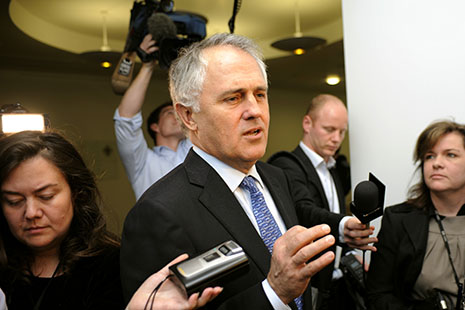A DOUBLE DISSOLUTION next year on legislation for Kevin Rudd’s Carbon Pollution Reduction Scheme, or CPRS, would not come as a bolt from the blue. Whatever target level of emission reductions the CPRS aims to achieve in 2020 and 2050, it will be contentious.
Climate sceptics are well represented in the Coalition. Two powerful sceptics are Senator Nick Minchin, opposition leader in the Senate, and Andrew Robb, who is responsible for opposition policy on the CPRS. Nationals Senate leader, Barnaby Joyce, and fellow Queensland senator, Ron Boswell, are also sceptics. Malcolm Turnbull is not, and in fact took the first step forward – as environment minister in the Howard government – by banning incandescent light bulbs.
The independent South Australian Senator, Nick Xenophon, says the Treasury modelling on the CPRS is based on “best-case or fantasy scenarios” and has “far too many assumptions.” He might not know it, but modelling is all about assumptions, which is why many are reluctant to accept modelling per se. But estimates simply can’t be made about what 2020, let alone 2050, will bring, and modelling is therefore the only alternative. Anyone can debate assumptions, but nevertheless assumptions have to be made. Xenophon and Family First senator Steve Fielding are two opportunists and it is difficult to know how they would vote when it came to the crunch.
The Greens, on the other hand, will inevitably claim that the level of emission cuts and the coverage of the CPRS does not measure up to what is required. Getting the legislation through the Senate will therefore be difficult. If the government fails to receive support from the Coalition, then Rudd must rely on the support of Xenophon, Fielding and all the Greens. To lose one of their votes would cost Rudd his legislation. Xenophon, Fielding and the Greens would all welcome a double dissolution, since it halves the quota of votes needed to elect a senator in any state from 14.28 per cent to 7.69 per cent.
Climate change minister Penny Wong claims Malcolm Turnbull has been rolled by the climate change sceptics among the Liberals, hence his demand that an emission trade scheme be delayed for at least a year. It’s more likely that Turnbull is listening to some sections of business, particularly the so-called trade-exposed industries and the power generators who are looking for a leg up, either by free emission permits or cash assistance, or a combination of both, plus a delay past 2010 to a trading scheme. Another factor is the parlous state of the Liberal Party finances in nearly all states and federally. Turnbull is a wealthy man, but he can’t be expected to fund the next election campaign. He is looking for money from business.
But another section of business, including the Australian Institute of Superannuation Trustees (in charge of billions in investments), the Property Council and the Australian Green Infrastructure Council, is keen for government policy to be directed towards encouraging “green jobs” in renewable and clean energy technology.
Rudd’s CPRS legislation should go into the parliament in the autumn session, beginning 3 February. If it is blocked or voted down in the Senate, Rudd must wait for three months before resubmitting the legislation and, if it is again voted down or blocked, he could call a double dissolution election around the middle of 2009. All senators (not the normal half of the Senate) must then face the voters, which is why the quota is effectively halved.
Add to the mix the fact that the latest Newspoll is terrible for Turnbull. At the election in November 2007 the two-party preferred the outcome was Labor 52.7 per cent, Coalition 47.3 per cent. Newspoll (taken 5–7 December) has Labor at 59 per cent and the Coalition at 41 per cent. Rudd is in a far more powerful position than he was at the last election. The primary vote is Labor 48 per cent (up 6 per cent in a fortnight), Coalition 35 per cent (down 3 per cent). The Coalition two-party preferred vote of 41 per cent is what the Coalition’s primary vote must be in an election if it is to have any hope. The Greens’ primary vote has held up well in the face of the big Labor advance and is on 10 per cent (down only 1 per cent). Green preferences will give Labor a big advantage at the next election.
Rudd’s satisfaction rating, at 70 per cent (up 3 per cent), is the highest ever recorded by a PM. Turnbull’s satisfaction rating has fallen to 47 per cent (down 5 per cent). As preferred PM Rudd is on 66 per cent (up 3 per cent) with Turnbull languishing on 19 per cent (down 2 per cent). Turnbull is now behind as preferred PM by the same margin Brendan Nelson was adrift when he was booted out.
Given this poll, it is difficult to believe Turnbull would want to face a double dissolution election in the middle of next year on the issue of climate change. But stranger things have happened in politics. It could be that Turnbull simply couldn’t bring the Coalition with him to support the government’s legislation. One plus for him is that the depressing Newspoll could bring many in the party room to their senses and the realisation that the only way forward is to support Turnbull. Bad as the polls may be, there is no serious alternative leader for the Liberals to turn to. •




